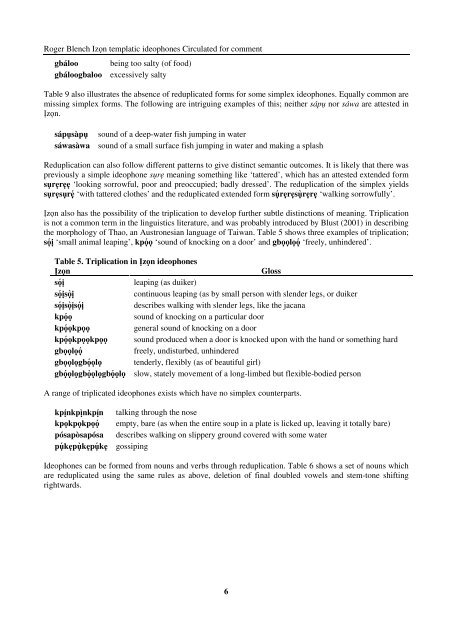Kolokuma ideophones.pdf - Roger Blench
Kolokuma ideophones.pdf - Roger Blench
Kolokuma ideophones.pdf - Roger Blench
You also want an ePaper? Increase the reach of your titles
YUMPU automatically turns print PDFs into web optimized ePapers that Google loves.
<strong>Roger</strong> <strong>Blench</strong> Izọn templatic <strong>ideophones</strong> Circulated for comment<br />
gbáloo being too salty (of food)<br />
gbáloogbaloo excessively salty<br />
Table 9 also illustrates the absence of reduplicated forms for some simplex <strong>ideophones</strong>. Equally common are<br />
missing simplex forms. The following are intriguing examples of this; neither sápụ nor sáwa are attested in<br />
Nzọn.<br />
sápụsàpụ sound of a deep-water fish jumping in water<br />
sáwasàwa sound of a small surface fish jumping in water and making a splash<br />
Reduplication can also follow different patterns to give distinct semantic outcomes. It is likely that there was<br />
previously a simple ideophone sụrẹ meaning something like ‘tattered’, which has an attested extended form<br />
sụrẹrẹẹ ‘looking sorrowful, poor and preoccupied; badly dressed’. The reduplication of the simplex yields<br />
sụrẹsụrẹ́ ‘with tattered clothes’ and the reduplicated extended form sụ́ rẹrẹsụ̀rẹrẹ ‘walking sorrowfully’.<br />
Nzọn also has the possibility of the triplication to develop further subtle distinctions of meaning. Triplication<br />
is not a common term in the linguistics literature, and was probably introduced by Blust (2001) in describing<br />
the morphology of Thao, an Austronesian language of Taiwan. Table 5 shows three examples of triplication;<br />
sọ́ ị ‘small animal leaping’, kpọ́ ọ ‘sound of knocking on a door’ and gbọọlọọ́ ‘freely, unhindered’.<br />
Table 5. Triplication in Nzọn <strong>ideophones</strong><br />
Nzọn<br />
Gloss<br />
sọ́ ị<br />
leaping (as duiker)<br />
sọ́ ịsọ̀ị<br />
continuous leaping (as by small person with slender legs, or duiker<br />
sọ́ ịsọ̀ịsọ́ị<br />
describes walking with slender legs, like the jacana<br />
kpọ́ ọ<br />
sound of knocking on a particular door<br />
kpọ́ ọkpọọ<br />
general sound of knocking on a door<br />
kpọ́ ọkpọọkpọọ sound produced when a door is knocked upon with the hand or something hard<br />
gbọọlọọ́<br />
freely, undisturbed, unhindered<br />
gbọọlọgbọ́ọlọ tenderly, flexibly (as of beautiful girl)<br />
gbọ́ ọlọgbọ̀ọlọgbọ́ ọlọ slow, stately movement of a long-limbed but flexible-bodied person<br />
A range of triplicated <strong>ideophones</strong> exists which have no simplex counterparts.<br />
̣ ̣ ̣<br />
kpínkpìnkpín<br />
talking through the nose<br />
kpọkpọkpọọ́ empty, bare (as when the entire soup in a plate is licked up, leaving it totally bare)<br />
pósapòsapósa describes walking on slippery ground covered with some water<br />
pụ́ kẹpụ̀kẹpụ́ kẹ gossiping<br />
Ideophones can be formed from nouns and verbs through reduplication. Table 6 shows a set of nouns which<br />
are reduplicated using the same rules as above, deletion of final doubled vowels and stem-tone shifting<br />
rightwards.<br />
6

















